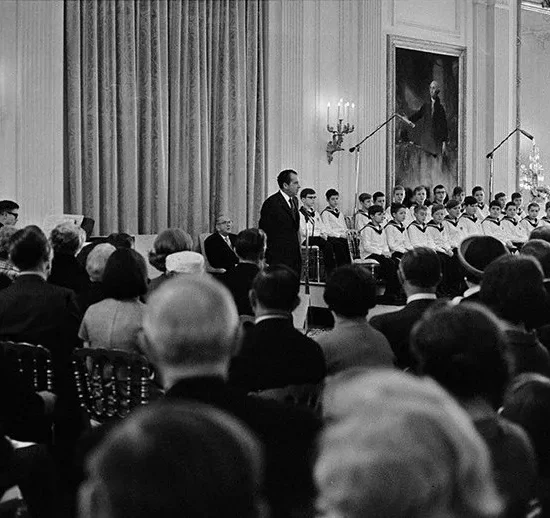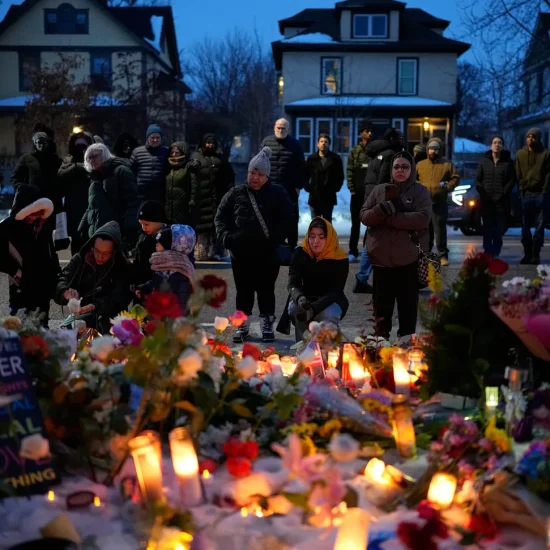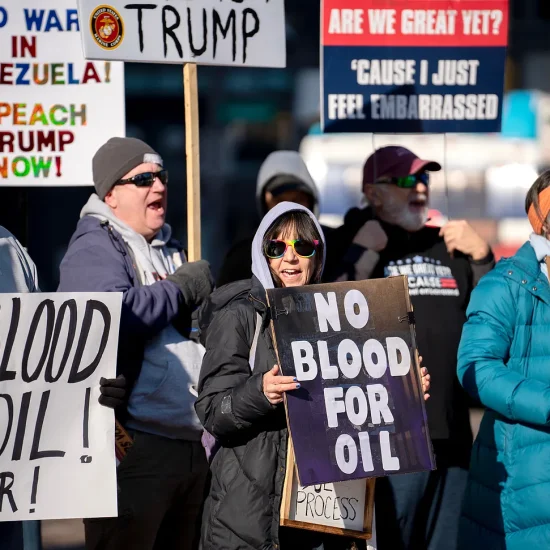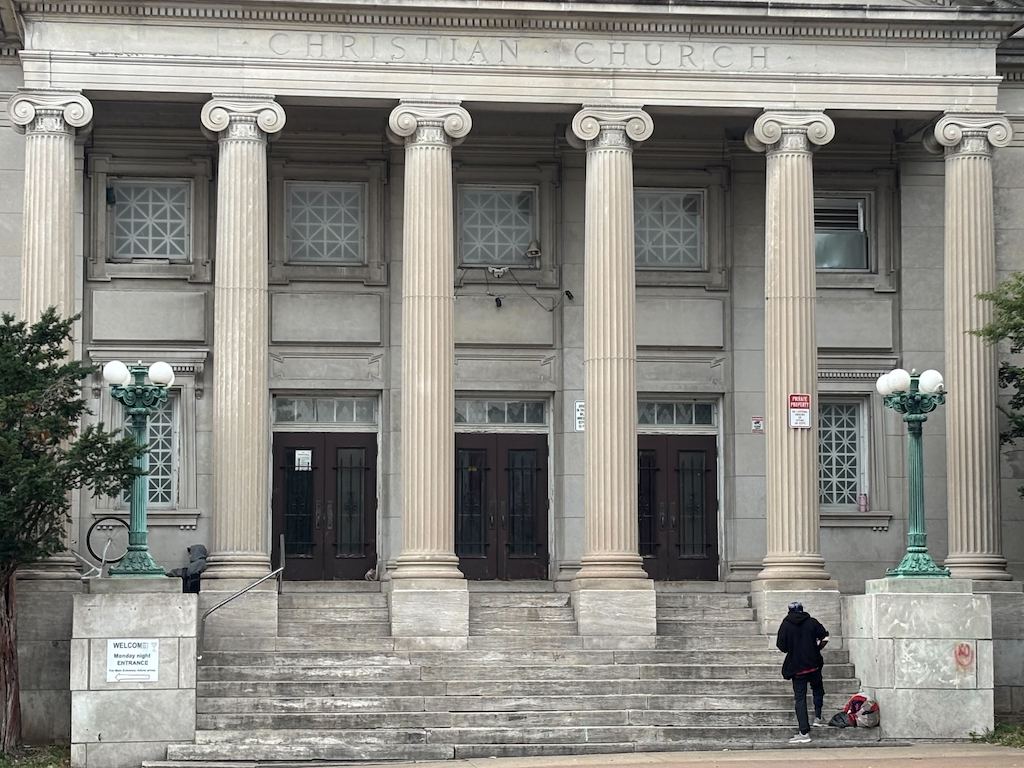
KANSAS CITY, Mo. — A man slept on the cool, gray steps of Independence Boulevard Christian Church, the building and its columns shielding his body from the midday sun on a recent weekday. A few others lingered in the shade under nearby trees.
On Monday evenings, the more-than-century-old church in Historic Northeast Kansas City opens its doors to people in need. It offers a free meal, hygiene products, clothing, and a medical clinic. Hundreds often come.
President Donald Trump’s nationwide gerrymandering push has now also arrived at the church’s literal doorstep.
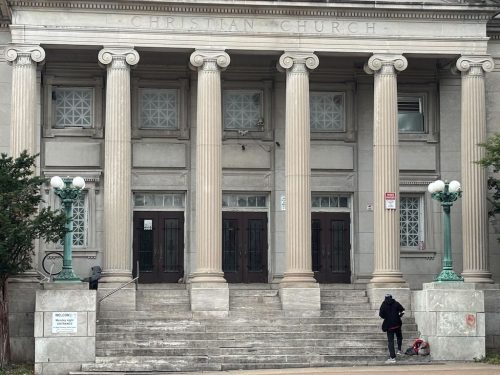
The steps of Independence Boulevard Christian Church, shown on Sept. 5, are a frequent resting spot for homeless people in Northeast Kansas City. A redistricting plan advanced by Missouri Republicans would divide the intersection where the church is located among three congressional districts. (Photo by Jonathan Shorman/Stateline)
Northeast Kansas City currently sits comfortably inside Missouri’s 5th Congressional District, which encompasses much of the city and the surrounding metro area. U.S. Rep. Emanuel Cleaver, an 80-year-old Democrat who was the city’s first Black mayor in the 1990s, has held the seat for 20 years.
But Missouri Republicans are advancing a redrawn congressional map through the state legislature that aims to give the party a political advantage. It would crack the city’s urban core into three districts — with all of them converging on the corner of Independence Avenue and Gladstone Boulevard, home to Independence Boulevard Christian Church.
The intersection’s southwest corner, where the church is located, would move into the 4th Congressional District, currently held by U.S. Rep. Mark Alford, a second-term Republican who was previously a TV news anchor. The southeast corner, a parking lot, would stay in a 5th District reshaped to embrace a much more rural and conservative constituency.
The northern side, lined by red-brick apartments and a meat market, would join the 6th District. Held by Republican U.S. Rep. Sam Graves since 2001, it would stretch across the state to the Illinois border.
Residents say they fear that dividing the area, with its complex interplay of problems and positive qualities, will dilute their voice in Washington, D.C.
“We need somebody to understand what poverty looks like,” the Rev. Mindy Fugarino, the church’s senior pastor, told Stateline as she described her problems with the gerrymander and how it will weaken the neighborhood’s representation.
“We need somebody to understand, what are the needs for housing,” Fugarino said. “We need somebody to understand what are the needs for fair wages and health care and those kind of things in a community where people are literally living and sometimes dying on the street.”
The Missouri House passed the new map in a 90-65 vote Tuesday, sending it to the state Senate. The Senate could begin work on the map as early as Wednesday.
The Missouri gerrymander marks the latest example of a Republican-controlled state heeding Trump’s call to redraw congressional districts. Creating more GOP-leaning districts would maximize the party’s chances of retaining control of the U.S. House after the 2026 midterm elections.
Democrats, both in Missouri and across the country, have condemned the effort as election-rigging. California has retaliated by asking its voters to approve a Democratic gerrymander. Republicans say they want to ensure Congress can advance Trump’s priorities, and they emphasize that federal courts allow partisan gerrymandering.
In Kansas City, the redistricting plan has set off a bitter political battle that’s left many people feeling angry and dismissed. Stateline spoke with residents, business owners, activists and local officials in Northeast Kansas City, where three districts would divide the area, to better understand the consequences of the national gerrymandering effort at the local level.
Northeast Kansas City residents and others broadly described a diverse, multicultural community with beautiful architecture, a strong civic fabric, and neighborhood pride. In the blocks immediately surrounding the intersection of Independence Avenue and Gladstone Boulevard, less than a third of residents are non-Hispanic white, according to census data.
At the same time, homelessness and crime can be a part of life. Residents are balancing a need for local investment against the risks of gentrification. The poverty rate fluctuates wildly within the area, from less than 12% of residents in some blocks to more than 63% in others. Vacant storefronts are sometimes only a short walk from colorful, tidy houses.
Most community members Stateline spoke with oppose the redistricting effort.
“Nobody asked for this,” said Edgar Palacios, the founder of Latinx Education Collaborative and Revolución Educativa, nonprofit organizations based in Northeast Kansas City that seek to foster Latino representation in education locally. His own home would move into the 4th District under the plan.
Palacios, the son of Nicaraguan immigrants, worried the gerrymander would lead to new representatives for the area who won’t understand the challenges of an urban environment.
“They’re not going to understand the nuances of urban public education and they’re not going to appreciate the differences in how money gets spent or why it gets spent that way or why it’s necessary to do certain things,” Palacios said.
Dan Smith runs Eleos Coffee House on Independence Avenue. The 14-year-old coffee shop is a nondenominational Christian ministry that Smith said draws in both people coming to just work or hang out and individuals off the street wanting help.
Smith declined to offer an opinion on the redistricting proposal, but said he hoped politicians will “totally forget about those lines” when making decisions.
“Because that’s what we have to do here at Eleos,” Smith said. “We can’t draw lines, you know — ‘well, as long as you’re in this group of people or as long as you don’t identify this way or as long as you don’t do this’ — I mean, that’s not helpful for anybody.”
Missouri politics
Trump set off a gerrymandering rush this summer in an effort to shore up Republican chances to keep control of the U.S. House in the 2026 midterm elections.
He initially demanded Texas redraw its maps to potentially provide up to five additional GOP seats, and has since urged Republicans in other states to do the same. California has retaliated and other Democratic states may follow.
Republicans in Missouri and elsewhere have been upfront that they are shuffling the map with the intention of improving their party’s standing and say their efforts are in line with a U.S. Supreme Court’s 2019 decision that greenlit political gerrymandering.
Republicans already hold six of the state’s eight U.S. House seats. Cleaver is one of two Democrats, along with U.S. Rep. Wesley Bell of the 1st Congressional District in St. Louis.
At most, the new map would likely enable Republicans to take the 5th Congressional District — a single seat — at the cost of a divided Kansas City.
Kansas City is home to some 516,000 people in an overall metro area of 2.2 million. The city is in the midst of a sports golden era that has been a boost to local pride: The Kansas City Chiefs have appeared in five Super Bowls over the past six years and won three; the city hosted the NFL Draft in 2023; it will host World Cup soccer matches next summer. Music star Taylor Swift’s frequent visits to the metro area to see fiancé Travis Kelce, the Chiefs player, have helped, too.
But gun violence remains a persistent problem. As other major cities have experienced falling homicide rates coming out of the pandemic, Kansas City broke its homicide record in 2023. Killings then fell last year, but nonfatal shootings jumped.
Kansas City leaders say their options to respond are constrained. Unlike nearly every major American city, Kansas City doesn’t control its police force. Instead, city-funded officers are overseen by commissioners almost entirely appointed by the governor, a policy with Civil War-era roots. And Missouri lawmakers have almost entirely preempted the city’s ability to restrict firearms.
For some Kansas Citians, the gerrymandered map strikes them as only the latest instance in a long history of Missouri exercising power with little regard for residents. The map cuts much of Kansas City into two along Troost Avenue — once a dividing line during the era of racial redlining that is still shorthand today for the split between the city’s predominantly white and Black neighborhoods.
“It’s sad that they go to this length to try, in my opinion, to disenfranchise people,” said Lonnie Beattle, a retired postal worker who said she lives in the 18th Street and Vine Street neighborhood that’s south of the Northeast Kansas City area.
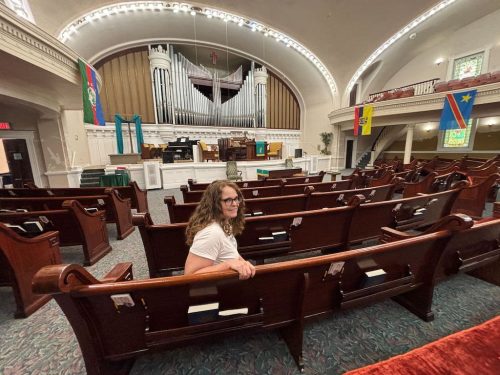
The Rev. Mindy Fugarino, senior pastor of Independence Boulevard Christian Church, sits inside the church’s sanctuary on Monday, Sept. 8. Fugarino opposes a plan to gerrymander Missouri’s congressional districts. (Photo by Jonathan Shorman/Stateline)
Basic needs
At Independence Boulevard Christian Church on Monday afternoon, preparations were already underway for that evening’s meal.
Tables and chairs were set up in a large basement hall, with a separate space available for families. Fugarino, the pastor, said the church expected to serve some kind of ham-and-turkey casserole.
In a few hours, their guests would arrive.
Later that afternoon and 150 miles away at the state Capitol, lawmakers would begin debating the bill that would split apart the crossroads of Independence Avenue and Gladstone Boulevard.
“I think the whole point,” Fugarino said in an interview about the gerrymander, “has nothing to do with trying to address what citizens are actually needing.”
Stateline’s Tim Henderson contributed reporting. Stateline reporter Jonathan Shorman can be reached at jshorman@stateline.org.
Stateline is part of States Newsroom, a nonprofit news network supported by grants and a coalition of donors as a 501c(3) public charity. Stateline maintains editorial independence. Contact Editor Scott S. Greenberger for questions: info@stateline.org.


